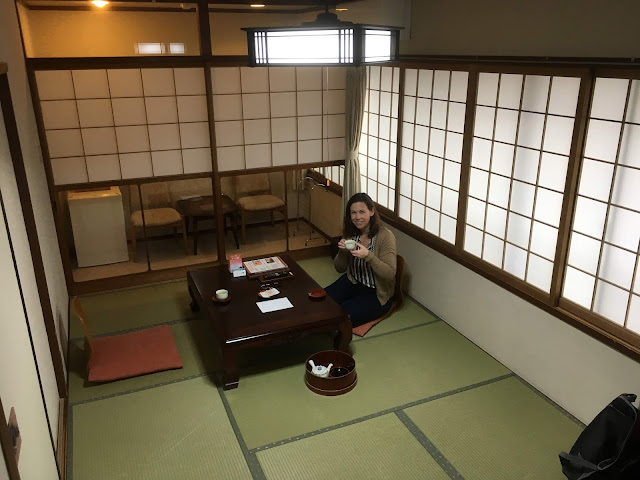We took the very scenic Hida Wide Express train from Kyoto
to the mountain town of Takayama. We had booked two nights at a ryokan, a
traditional Japanese inn. Ryokans typically provide one or two meals, and
usually have an onsen-style bath onsite. We thought it would be a good way to
immerse ourselves in Japanese culture. At the main entrance to the inn, we
exchanged our street shoes for house slippers and we were shown to our room.
As you can see, there was not much decoration in the room –
the floor was covered with finely-woven straw tatami mats, there was a low table and some cushions
to sit on, and not much else. (In the
alcove there were two western-style chairs and a mini-fridge. We ended up spending a surprising amount of time sitting in that tiny room). You might be
wondering, where is the bed? Yeah, we
wondered that too. It turns out the bedding was all folded up in a cupboard
near the room entrance. A two-person turndown team came around each night after
dinner to set up the thin futon mattress on the floor. Then they came and put
it away again each morning!
So the comfort level of the room itself left a little bit to
be desired. But our primary reason for booking a ryokan was to try a traditional
kaiseki dinner. The dinner is served in your room by your own personal maid/waitress
who sets the table and brings the dishes in multiple courses, all very
artistically arranged.
On its website, our ryokan boasts (proudly and repeatedly) that they "specialize in the local Hida beef”. Like Kobe beef, Hida beef comes from Japanese Wagyu
cattle that are specifically bred for the fine quality of fat marbling throughout
each cut.
Seated awkwardly on the floor, we actually cooked the beef course of each meal
ourselves. (I guess we are the true Hida beef specialists now!) The first night it was shabu-shabu style -- thin strips of beef cooked
quickly in boiling broth. The second night it was thicker slabs of beef barbecued on a tiny hibachi
grill. Both meals were truly delicious. Kanpai to the chef!
However, the breakfast was not so delicious, to be honest. We both consider ourselves to be pretty adventurous eaters, and will try anything once. But rubbery seaweed and
salted fish is just not what I typically crave when I think of breakfast food. It
was a bit of an ordeal to get through all the dishes they served at breakfast. Hey,
at least we got to sit in normal chairs though!
With our bellies full, we then set about exploring the town despite the rain. At least we didn't have to fight any crowds.
Takayama has a beautiful old town area, with traditional
wooden buildings lining the main street and lots of boutique shops selling
handicrafts, local foods, and even several sake vendors. Even in the rain it
was a charming place.
On our second day in town, we explored the morning market followed by a walk to the Sakurayama Hachimangu shrine, the oldest shrine in Takayama.
Then we headed inside the Festival Float Exhibition Hall. Takayama
is particularly famous for its Matsuri, a festival that takes place twice a
year – in April and October. They have
held this festival for the past 350 years, culminating in a parade of gilded
wooden floats that are manually carried or pulled through the streets. (Some have wheels and some do not). Several
of the floats have moveable marionettes that perform for the crowds. Unfortunately we were visiting about a week too
early to be able to see the Spring Festival, but we were happy to be able to
see the floats on display at this excellent little museum.
Our final stop in Takayama was the Hida Folk Village (Hida
No Sato). This is an outdoor museum displaying various regional architectural
styles. More than 30 historical and culturally important buildings were moved
to this location to preserve them for future generations.
Traditional architecture in the area includes farmhouses
built in the Gassho style, having thick thatched roofs that are steeply pitched
to withstand the weight of snowfall in this part of Japan. Inside, a large open
hearth sunk into the middle of the floor provides heat and a space for cooking.
Considering how chilly and rainy it was during this part of our trip, I can see
why the farmers of this area would want a cozy thatched-roof cottage when the
winter snows hit.













No comments:
Post a Comment